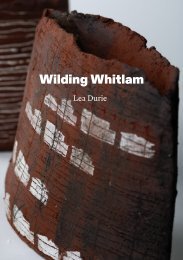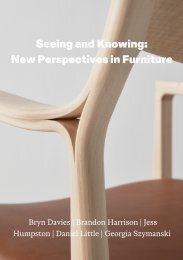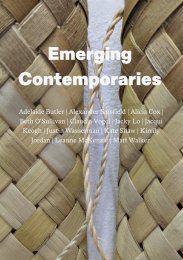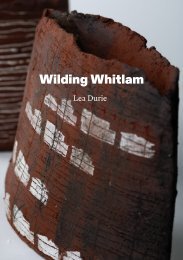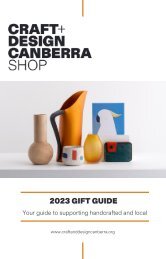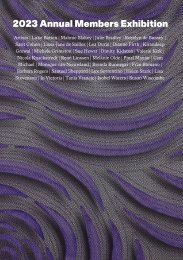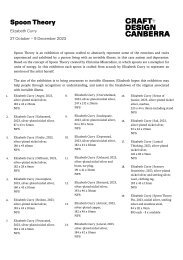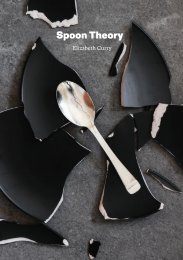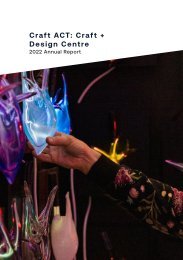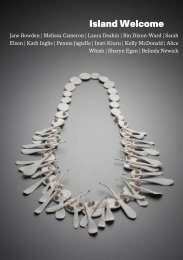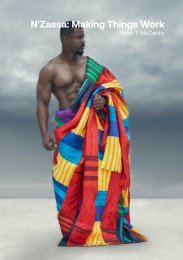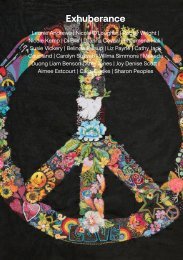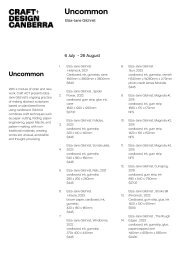HOME:MADE
HOME:MADE features a curated selection of new furniture, homewares and jewellery by some of the most exciting early-career designers and makers from across Australia. HOME:MADE is a signature exhibition for DESIGN Canberra presented by Craft ACT: Craft + Design Centre. In 2020, we will present this showcase exhibition in association with the Australian Craft + Design Centre network.
HOME:MADE features a curated selection of new furniture, homewares and jewellery by some of the most exciting early-career designers and makers from across Australia.
HOME:MADE is a signature exhibition for DESIGN Canberra presented by Craft ACT: Craft + Design Centre. In 2020, we will present this showcase exhibition in association with the Australian Craft + Design Centre network.
Create successful ePaper yourself
Turn your PDF publications into a flip-book with our unique Google optimized e-Paper software.
<strong>HOME</strong> <strong>MADE</strong>
One city<br />
200+ events<br />
DesignCanberraFestival.com.au<br />
Exhibition on display at Canberra Contemporary Art Space as part of the<br />
DESIGN Canberra festival (9-29 November 2020).<br />
Tuesday-Sunday, 11am-5pm<br />
44 Queen Elizabeth Terrace, Parkes ACT 2600<br />
Cover image: Mavis Marks, Women’s business fabric and Chi Yusuf, The<br />
Branch desk and chair, 2019. Photo: Lean Timms<br />
This page: Kristin Burgham, Aberration (Loving cup), 2020. Photo: Lean Timms<br />
2
9—29 November<br />
3
<strong>HOME</strong>:<strong>MADE</strong><br />
Exhibition statement<br />
<strong>HOME</strong>:<strong>MADE</strong> 2020 features a curated<br />
selection of new furniture, homewares<br />
and jewellery by some of the most exciting<br />
early-career designers and makers from<br />
across Australia. The exhibition features<br />
work by emerging and established<br />
designers from almost every state and<br />
territory, as part of an important strategy<br />
to build support for local independent<br />
studio practice and small-scale Australian<br />
manufacturing. It promotes Australian<br />
contemporary design and supports<br />
designers to earn a living from their<br />
practice.<br />
Craft ACT gratefully acknowledges<br />
generous support from Canberra<br />
Contemporary Art Space for making their<br />
new gallery on the shores of Lake Burley<br />
Griffin available for this beautiful and<br />
important exhibition.<br />
<strong>HOME</strong>:<strong>MADE</strong> is a signature exhibition for<br />
DESIGN Canberra presented by Craft ACT:<br />
Craft + Design Centre and supported by<br />
the Australian Craft and Design Centre<br />
network which includes JamFactory,<br />
Design Tasmania, Central Craft, Artisan,<br />
Sturt School for Wood, Canberra<br />
Glassworks and Craft Victoria, among<br />
others. These acclaimed organisations<br />
advocate for craft practitioners and<br />
designers. The exhibition has been curated<br />
by the festival’s artistic director, Rachael<br />
Coghlan, with support from Madisyn<br />
Zabel, Craft ACT gallery manager.<br />
Image: Calum Hurley, #3 Chair001 (Grey), Minqi Gu,<br />
Cloud necklace, Jenna Lee, Story carriers 1-3.<br />
Photo: Lean Timms<br />
5
Exhibition essay<br />
Penny Craswell<br />
What makes a designer or a maker<br />
choose to create an object from scratch?<br />
Home: Made 20 is an exhibition of new<br />
works by early career designers and<br />
makers that presents the breadth of<br />
furniture, homewares and jewellery being<br />
created in Australia today.<br />
The act of creation, of actualising a<br />
three-dimensional form, starts with an<br />
idea. Faced with the seemingly infinite<br />
possibilities of creating something<br />
from nothing, designers and makers<br />
take inspiration from a huge variety of<br />
sources. Home: Made 20 is an exhibition<br />
of new works by emerging designers<br />
and makers that shows the diversity of<br />
creative practice and the imaginative<br />
power of young creatives.<br />
Decolonising history is a driving force<br />
for the work of Indigenous women<br />
Jenna Lee (Larrakia, Wardaman and<br />
Karajarri) and Krystal Hurst (Worimi).<br />
Jenna Lee’s Story Carriers are woven<br />
vessels made from the pages of a<br />
book and bound with red thread that<br />
symbolises the retrospective addition of<br />
First Nations authority to the pages of<br />
books “in the same way in which red pen<br />
is used to correct and edit documents<br />
prior to publishing,” explains the artist.<br />
Jeweller Krystal Hurst’s work also<br />
explores themes of resilience and power.<br />
Resilience is a necklace with imitation<br />
echidna quills and wattle seeds made<br />
from bronze metal. It was created in<br />
response to the attempt to hide and<br />
remove First Nations perspectives from<br />
Australian history.<br />
Culture, Country and storytelling are<br />
behind the work of three Indigenous<br />
textile designers, Eunice Napanangka<br />
Jack (Ngaanyatjarra), Mavis Nampitjinpa<br />
Marks (Luritja and Pintupi) and Keturah<br />
Zimran (Luritja and Pintupi). Created<br />
in collaboration with Ikuntji Artists and<br />
screen printed by Publisher Textiles and<br />
Papers, these designs are deeply linked<br />
to the landscape. Eunice Napanangka<br />
Jack’s textiles depicts her father’s<br />
Tjukurrpa (Dreaming) and show the<br />
country at Kuruyultu near Tjukurrla in<br />
Western Australia – a deep waterhole<br />
in a small mountain range. For Keturah<br />
Opposite: Chi Yusuf, Branch chair. Krystal Hurst, Echidna<br />
quills necklace. Samantha Dennis, Untitled studies -<br />
Coleoptera series. Photo: Lean Timms<br />
7
Zimran, the natural rock formations<br />
(puli) found in and around Haasts Bluff<br />
230km west of Alice Springs are her<br />
inspiration. And Mavis Nampitjinpa<br />
Marks’s work is inspired by women’s<br />
Ceremonial Dancing at Mt Liebig,<br />
depicting body painting, as well as the<br />
story given to her by her grandfather of<br />
Kalipinpa the Water Dreaming.<br />
Australia’s landscape and unique flora<br />
and fauna are also the inspiration<br />
for non-Indigenous jewellery artists<br />
Danielle Barrie, Samantha Dennis<br />
and Zoe Grigoris. Danielle Barrie’s<br />
fascination with nature was heightened<br />
during the COVID-19 lockdown, when she<br />
found herself retreating to nature and<br />
spending time to notice details “from<br />
lichen on tree branches to geometric<br />
cactus growth”. Her work Wistful Small<br />
Earrings is inspired by the complexity of<br />
the wisteria plant. For Zoe Grigoris, the<br />
patterns of flowers and other plants are<br />
pressed into a sheet of precious metal,<br />
creating a subtle effect informed by<br />
illustration. And Samantha Dennis’s work<br />
focuses on insects rather than plants.<br />
Coleoptera is a series of oversized bugs<br />
cast in porcelain, hand detailed, fired<br />
and glazed and then pierced with sterling<br />
silver oxidised to resemble a dark<br />
underbelly.<br />
Timothy Robertson’s Lande Chair brings<br />
forms inspired by Australian flora to<br />
his design, whose curved shell form is<br />
reminiscent of Mid-Century modernist<br />
chairs. Colours selected for the moulded<br />
leather are brown and green also<br />
reflecting the colours of nature.<br />
From the universality of landscape to<br />
the whimsical. Minqi Gu is a jewellery<br />
and small object designer whose<br />
work cannot be bound by one material<br />
or technique. Her curious approach<br />
playfully embraces failure, while<br />
exploring concepts of cultural difference,<br />
consumerism and health. Bold in colour<br />
and form, her work is light-hearted<br />
and defies definition. Cloud is made<br />
from copper, steel, string and enamel<br />
paint – a necklace with a simple almost<br />
cartoonish shape that will certainly put a<br />
smile on your face.<br />
Similarly playful is the work of Kazu<br />
Quill, whose prototype for a modular<br />
self-massage chair features a square<br />
seat with round red leather insert and<br />
red balls on sticks inserted into the chair<br />
to act as part chair back and part back<br />
massager – these can be moved around<br />
at whim. Reminiscent of the works of<br />
Memphis and the postmodernist period<br />
Image: Jenna Lee, Story carriers, 2020, pages of<br />
‘Aboriginal Words and Place Names’, bookbinding thread,<br />
varnish, dimensions varible. Photo: Lean Timms
in furniture design, the result is not so<br />
much a functional massage chair as<br />
a playful interactive interrogation of a<br />
chair.<br />
From the playful to the functional, Rene<br />
Linssen’s design for a Sola coffee table<br />
with recessed shelf is a tweak on a<br />
universal form that allows it to be utilised<br />
in a new way. With two contrasting<br />
materials – steel and marble – and<br />
simple geometries, the table is made<br />
interesting by an interactive element – a<br />
marble disc can act as a tabletop but,<br />
when removed, reveals a recessed shelf<br />
for placing drinks.<br />
Calum Hurley’s #3 Chair001 was inspired<br />
not by its use, but by a trip to Japan.<br />
Captivated by the Japanese architecture<br />
and urban landscapes, Calum took<br />
thousands of photos and then chose<br />
six as inspiration for his stool, made of<br />
powder-coated steel, jesmonite (an eco<br />
lightweight substitute for cast concrete)<br />
and hand-spun woollen upholstery.<br />
Still in furniture design, two beautiful<br />
objects in wood show there is still<br />
significant passion for this basic yet<br />
universal material. Jordan Leeflang’s<br />
#3 Loft Chair is made using jigs<br />
and templates to create a series of<br />
repeatable elements, creating angles,<br />
folds and joins for the luscious walnut<br />
wood of the chair. Likewise, Chi Yusuf’s<br />
desk is another love letter to walnut –<br />
this time the timber is combined with<br />
black leather to create a luxurious object<br />
for the home. The shape of the legs<br />
inspired by tree branches, give the desk<br />
and chair their name – Branch.<br />
Also interested in materials in new<br />
furniture design is Scott Van Tuil<br />
and Chloe Goldsmith. Scott Van<br />
Tuil’s ‘Turbine bowl’ table is inspired<br />
by Tasmania’s engineering history.<br />
This pieces is a reference to Hydro<br />
Engineering with its sharp form and<br />
mirror finish stainless steel construction.<br />
Chloe Goldsmith’s plant pots are inspired<br />
by the materiality of architecture rather<br />
than engineering. And it is the use of<br />
that favourite material of architects –<br />
terrazzo – that brings these objects from<br />
the architectural scale down to the level<br />
of an object.<br />
Kristin Burgham and Peta Berghofer,<br />
both ceramicists, also use materials as<br />
an important starting point in their work.<br />
Kirstin collects found objects and uses<br />
their forms to create a cast – the objects<br />
that are then made using this cast create<br />
a simulacrum of the original, complete<br />
with seams and scars of their prior life.<br />
10
Peta’s work also subverts expectations<br />
in ceramics, starting with traditional<br />
ceramic forms and disrupting their<br />
functionality to explore the line<br />
between art and craft.<br />
For Madisyn Zabel, materials are also<br />
vital – this time glass. She plays with<br />
shifting geometries, perception and<br />
illusion, creating objects whose forms<br />
are inspired by the shapes created<br />
when viewing a simple wire-frame cube<br />
from a number of different oblique<br />
angles.<br />
Australians are opening their homes<br />
up to contemporary craft and<br />
design like never before – original<br />
handmade pieces bring with them<br />
stories, authentic materiality and<br />
pride in the local. This story of what<br />
inspires a designer or maker to create<br />
is ultimately what makes an object<br />
resonate with us, forging a personal<br />
connection borne from a single kernel<br />
of inspiration.<br />
Penny Craswell<br />
Sydney-based editor, writer and curator<br />
specialising in design and architecture<br />
Opposite: René Linssen, Sola Coffee Table, powdercoated<br />
steel, marble, 85 x 85 40 cm. Photo: Lean Timms<br />
11
Image: Peta Berghofer, Leaky Bottles, 2020, dimensions variable. Photo: Courtesy of the artist
Guildhouse + JamFactory<br />
Australian Craft + Design Centre network
Danielle Barrie<br />
Artist statement<br />
“During the pandemic I found myself like<br />
many others retreating into nature, going<br />
for longer walks and noticing details that<br />
I previously rushed past. From lichen on<br />
tree branches to geometric cactus growth<br />
I was fascinated by the complexity of such<br />
small seemingly trivial natural details”,<br />
explains Barrie,<br />
Having more time at home, an excuse to<br />
slow down whilst simultaneously having a<br />
vague notion of what this year could have<br />
been, with changed plans and individual<br />
stories of sorrow, Barrie found parallels<br />
in this experience. Rushing from one job<br />
to the next, one meeting to another the<br />
reasons for your actions become faded<br />
and ambiguous, they are simply things<br />
that must be done or checked off.<br />
With this moment that is so<br />
‘unprecedented’ we have been forced to<br />
idle – having moments of leisurely joy<br />
mixed with a notion of wistfulness. Playing<br />
with this emotion and the structure<br />
of a wisteria plant, Barrie wanted to<br />
create a piece that was both simplistic<br />
in wearability and look, but complex in<br />
componentry and construction.<br />
Biography<br />
Danielle Barrie is a jewellery and object<br />
designer and maker currently based in her<br />
shared studio at the JamFactory, Adelaide<br />
South Australia. Having graduated from<br />
the University of South Australia with a<br />
Bachelor of Visual Arts Specialisation<br />
(Jewellery & Metal) in 2015 she was<br />
grateful to be accepted into the world<br />
renowned JamFactory associate program<br />
which she completed in 2017.<br />
Her first experiences with jewellery was<br />
watching her mother get ready each<br />
morning. From small detailed boxes she<br />
would pull out beautiful, intricate and<br />
precious remnants from years gone by.<br />
Each had a unique design and story of<br />
its own - some of these objects had been<br />
passed down and held memories of<br />
generations. She aims to create innovative<br />
and contemporary pieces that elude to<br />
a sense of history and time. I hope to<br />
handcraft timeless pieces that evoke<br />
an understated luxury with a refined<br />
playfulness.<br />
Image: Danielle Barrie, Wistful necklace, 2020, sterling<br />
silver and freshwater pearls, dimensions variable.<br />
Photo: Lean Timms
Artisan<br />
Australian Craft + Design Centre network
Peta Berghofer<br />
Artist statement<br />
Within two months of the First Fleet<br />
arriving to Australia, clay was dug to<br />
makes bricks and soon after, domestic<br />
ceramics. Bring a Plate #1 is a<br />
developmental series of sculptures which<br />
initiate long term practice-led research<br />
into colonial, Australian ceramics.<br />
The everyday functions of these ceramics<br />
are disrupted to re-position the colonial<br />
forms as cultural objects, signifying lesser<br />
known impacts of British colonialism<br />
on Aboriginal Australians. The forms<br />
represent the mimicking of British food<br />
practices, aiding in the colonist’s division<br />
from Aboriginal people and their practices.<br />
Featuring abstracted ginger beer bottles,<br />
a demijohn, a bowl, and a Wedgwood<br />
influenced vessel, the ceramics come<br />
together as a fictional table setting for<br />
Jonathan Leak, one of the first convict<br />
potters.<br />
Biography<br />
Peta Berghofer completed a Bachelor<br />
of Creative Arts (Visual Arts) at the<br />
University of Southern Queensland in<br />
2016, receiving First Class Honours. She<br />
began developing her practice at First<br />
Coat Studios in Toowoomba preceding<br />
this. After being awarded the Bellmaine<br />
French Appreciation Travelling Scholarship<br />
from USQ in 2017, Berghofer spent 2019<br />
attending artist residencies throughout<br />
France and Denmark to continue her<br />
creative development.<br />
Image: Peta Berghofer, Bring a plate, 2020, dimensions<br />
variable. Photo: Courtesy of the artist
Craft Victoria<br />
Australian Craft + Design Centre network
Kristin Burgham<br />
Artist statement<br />
Industrial ceramic production methods<br />
inspire Kristin Burgham’s practice.<br />
Working with found objects she spends<br />
time sorting and observing each object<br />
she finds. This allows her to consider the<br />
making process and contemplate the<br />
things themselves.<br />
The solid found object is transformed<br />
through the casting process into an empty<br />
void lined with seams and scars. It sits<br />
devoid of emotional connection or context<br />
and without the sensory distractions of<br />
material matter and colour.<br />
Biography<br />
Kristin has recently completed a BFA at<br />
RMIT majoring in Ceramics. She is uses<br />
industrial ceramic production methods<br />
such as mould making to work with and<br />
explore found objects. Burgham subverts<br />
the process of making by revealing not<br />
hiding production seams. Her porcelain<br />
assemblages evoke not only the<br />
memory of an object but the memory of<br />
anonymous makers within an industrial<br />
context.<br />
Burgham sees her finished works as a<br />
reflection of the anonymous industrial<br />
makers. These altered simulacra reflect on<br />
memory, loss and the ephemeral.<br />
Image: Kristin Burgham, Aberration (Middle bottle),<br />
Aberration (Tall bottle), Aberration (Loving cup) 2020,<br />
porcelain, dimensions variable. Photo: Lean Timms
Design Tasmania<br />
Australian Craft + Design Centre network
Samantha Dennis<br />
Artist statement<br />
Samantha Dennis’ work made for the<br />
<strong>HOME</strong>:<strong>MADE</strong> exhibition continues from<br />
a recent series titled ‘Coleoptera’. This<br />
series examines the unique and bizarre<br />
form of insects through hybrid, imagined<br />
and hyperbolic brooches. These one-off<br />
pieces juxtapose the usual trepidation<br />
or repulsion felt towards insects with the<br />
tactile and desirable nature of jewellery.<br />
The brooches are modelled and cast<br />
in porcelain, hand detailed and then<br />
layered with glazes which have metallic<br />
and crystalline elements. Once fired, a<br />
base is hand pierced from sterling silver,<br />
which is later oxidised to resemble a dark<br />
underbelly. Where possible, the pieces<br />
are made from a single sheet with legs<br />
or antennae folded out, leaving a window<br />
which mimics how beetles curl their legs<br />
under when found perished in nature,<br />
adding an unexpected curiosity at the<br />
brooch back.<br />
Biography<br />
Samantha Dennis is an early career<br />
Tasmanian artist inspired by biology and<br />
natural history, working with a range of<br />
materials including silver, ceramics and<br />
glass from her Launceston studio. She has<br />
received grants, residencies and project<br />
based funding from the Australia Council<br />
for the Arts, Regional Arts Fund and Arts<br />
Tasmania, and has been the recipient of<br />
the Design Tasmania Award (2019) FIND<br />
Contemporary Jewellery Bursary (2019)<br />
and Artentwine Small Sculpture Prize<br />
(2016).<br />
Image: Samantha Dennis, Untitled studies - Coleoptera<br />
series, 2020, cast and altered porcelain, hand pierced<br />
sterling silver (oxidised), various glazes and epoxy,<br />
approx 10 x 7 x 2 cm. Photo: Lean Timms
Australian Design Centre<br />
Australian Craft + Design Centre network
Chloe Goldsmith<br />
Artist statement<br />
Goldsmith’s ‘Pieces Planter’ applies the<br />
honest, tactile and elemental materials<br />
of architectural design, through the<br />
typology of the pot plant. Formed by<br />
rocks, minerals and precious metals,<br />
Pieces Planter is composed of simple<br />
terrazzo slabs, stacked together in perfect<br />
geometry, protecting the foundation of the<br />
plant and generously framing the foliage.<br />
Shoots cascade out and over; a glistening<br />
undercroft.<br />
Biography<br />
Chloe Goldsmith is a Newcastle<br />
based Architectural Designer currently<br />
undertaking a Master of Architecture at<br />
the University of Newcastle where she<br />
also tutors undergraduate students of<br />
architecture and performs academic<br />
research. She founded studio coeō<br />
through which she collaborates with<br />
others to work on residential, object and<br />
spatial design and making. She reveres a<br />
humble scale of residential architecture;<br />
intimate, rigorous and of simple delight.<br />
After completing her bachelor degree in<br />
architecture, she travelled to Tokyo to<br />
work with a studio exploring urban renewal<br />
and intervention, public installation<br />
and responsive environments. Since<br />
returning she has spent several years as<br />
an Architectural Designer at Tribe Studio<br />
Architects in Sydney while also designing<br />
and fabricating furniture and objects.<br />
Goldsmith has presented work in various<br />
international architectural workshops.<br />
Image: Chloe Goldsmith, Pieces planter, terrazzo, brass,<br />
20 x 29 x 29 cm. Photo: courtesy of Australian Design<br />
Centre
Guildhouse + JamFactory<br />
Australian Craft + Design Centre network
Zoe Grigoris<br />
Artist statement<br />
Zoe Grigoris’s work is informed by<br />
illustration. She uses mark-making<br />
techniques to replicate her detailed<br />
patterns and floral motifs in precious<br />
metal.<br />
Biography<br />
Zoe Grigoris is a contemporary jeweller<br />
and artist based in Adelaide, South<br />
Australia. She graduated from Flinders<br />
University in 2011 with a Bachelor of Arts<br />
Degree before completing a Bachelor of<br />
Visual Arts Specialisation (Jewellery &<br />
Metal) at the University of South Australia<br />
in 2014. In 2014 Zoe worked as a teaching<br />
assistant within the Jewellery and Metal<br />
studio at the University of South Australia.<br />
She worked with Adelaide jeweller Sarah<br />
Rothe in her studio and retail outlet in<br />
Adelaide’s CBD till 2016. Zoe completed<br />
the Associate Training Program in<br />
JamFactory’s Metal Design Studio in 2016<br />
and has continued to run her practice as a<br />
tenant at JamFactory.<br />
Image: Zoe Grigoris, Painted pattern studs, 2020,<br />
oxidised silver, enamel paint, dimensions variable.<br />
Photo: courtesy of the artist.
Artisan<br />
Australian Craft + Design Centre network
Minqi Gu<br />
Artist statement<br />
Minqi Gu playfully embraces failure<br />
through her curious explorations of<br />
cultural difference, consumerism<br />
and health. Bold and deliberate in<br />
colour, simple and suggestive in<br />
form and saturated in materiality, her<br />
architectural background brings a tryst<br />
to the conceptual and a light-hearted<br />
engagement with form and composition.<br />
Her work defies definition, appearing<br />
inconsistent in style and technique.<br />
The results are open-ended indefinable<br />
wearable objects, which may indeed<br />
challenge the definition of jewellery itself.<br />
This piece is a deliberately whimsical<br />
reflection on the relationship between<br />
form and subject matter.<br />
Biography<br />
Miss Minqi Gu is a Brisbane based artist<br />
and has a masters of architecture from the<br />
University of Sydney and has worked in a<br />
number of major Australian architectural<br />
firms up until 2011. She began making<br />
and designing mixed media jewellery in<br />
her spare time and now, apart from caring<br />
for her son, is focused mainly on her<br />
jewellery practice.<br />
Image: Minqi Gu, Cloud, 2020, copper, steel, polyester<br />
string and enamel paint, 10 x 7 cm with extended string<br />
35 cm. Photo: Lean Timms
Jam Factory<br />
Australian Craft + Design Centre network
Calum Hurley<br />
Artist statement<br />
Calum Hurley is an Adelaide-based<br />
furniture and object designer. Currently<br />
working out of JamFactory’s Furniture<br />
Studio as part of the esteemed Associate<br />
Training Program, Hurley produces objects<br />
that are consciously space-sensitive and<br />
visually distinct.<br />
Chair001 was designed by Hurley<br />
in response to his photographs of<br />
metropolitan Japan, shown as part of the<br />
2020 exhibition (with Jordan Leeflang),<br />
Differing Perspectives at Craft ACT.<br />
Biography<br />
Calum Hurley is an Adelaide based<br />
furniture and object designer. Currently<br />
working out of JamFactory’s Furniture<br />
Studio as part of the esteemed Associate<br />
Training Program, Hurley produces objects<br />
that are consciously space-sensitive and<br />
visually distinct. With a strong body of<br />
exhibition work, Hurley’s current practice<br />
looks to expand this with further solo and<br />
group exhibitions, whilst developing a<br />
number of these pieces into retail ready<br />
products.<br />
The red version of this chair was a finalist<br />
in the 2020 Denfair Front Centre program.<br />
Image: Calum Hurley, #3 Chair001 (Grey), 2020, powdercoated<br />
steel, jesmonite, hand-spun woolen upholstery,<br />
45 x 68 x 51 cm. Photo: Lean Timms
Craft ACT<br />
Australian Craft + Design Centre network
Krystal Hurst<br />
Artist statement<br />
Hurst’s work ‘Resilience’ explores themes<br />
of resilience and power as an attempt to<br />
decolonise hidden and removed Australian<br />
histories from the perspectives of First<br />
Nations artists. Hurst was a finalist in the<br />
prestigious Telstra National Aboriginal<br />
& Torres Strait Islander Art Awards<br />
(NATSIAA) for her piece, “Resilience” in<br />
2019 and more recently in 2020.<br />
Biography<br />
Krystal Hurst is a Worimi artist and<br />
creative director of Gillawarra Arts,<br />
originating from Taree on NSW’s mid<br />
north coast. Krystal is a jewellery designer,<br />
painter, print-maker and workshop<br />
facilitator whose inspiration derives<br />
from Country, memories, stories and<br />
community integrated in an innovative and<br />
contemporary way.<br />
Image: Krystal Hurst, Resilience, 2019, oxidised bronze<br />
metal and silk thread, 28 x 38 x 3 cm (framed).<br />
Photo: Craft ACT
Central Craft + Ikuntji Artists<br />
Australian Craft + Design Centre network
Eunice Napanangka Jack<br />
Artist statement<br />
This design by Eunice Napanangka Jack<br />
depicts her father’s Tjukurrpa (Dreaming).<br />
It shows the country at Kuruyultu, near<br />
Tjukurrla in Western Australia, a deep<br />
waterhole in a small mountain range, a<br />
‘rockhole’.<br />
This fabric has been screen printed by<br />
hand by Published Textiles and Papers,<br />
ensuring the highest quality and longevity.<br />
Biography<br />
Winner of the 2017 Moreton Bay Region<br />
Art Awards and a consistent exhibition<br />
history, Jack has been painting for<br />
three decades. Her early works were<br />
collaboratives with her husband, the late<br />
Gideon Tjupurrula Jack; she began a<br />
solo practice in 1992 and was a founding<br />
member of Ikuntji Artists which also<br />
started around this time. She uses layers<br />
of colour to build up a vision of the bush<br />
flowers and grasses. Highly collectable,<br />
Jack is represented in leading galleries<br />
worldwide.<br />
Jack’s paintings are interpretations of<br />
her country near Lake Mackay. Amongst<br />
this landscape Jack’s personal stories<br />
are told, either of the travelling of her<br />
tjukurrpa – the Bilby – or the people who<br />
once lived in the area. Her father was<br />
Tutuma Tjapangarti, one of the first men<br />
to paint for Papunya Tula. Jack also paints<br />
his country, which includes Tjukurla, Tjila,<br />
Kurulto and Lupul. Her mother was from<br />
the Walpiri side of Lake Mackay –<br />
Winparrku – in Western Australia.<br />
Image: Eunice Napanangka Jack, Kuruyultu fabric<br />
(detail), 2020, blended pink inks on natural tencel linen,<br />
70% tencel, 30% linen, 172gsm, 600 x 145 cm.<br />
Photo: Lean Timms
Craft Victoria<br />
Australian Craft + Design Centre network
Jenna Lee<br />
Artist statement<br />
Story Carriers 1-3 seek to reclaim the<br />
act of record and story-keeping through<br />
the physical acts of deconstruction and<br />
reconstruction. Using the pages of the<br />
book, Lee has created paper string that<br />
has been woven back together with the<br />
use of book binding thread. Presenting<br />
a new and elevated story held within the<br />
creation of their forms. The red thread<br />
represents the retrospective addition of<br />
First Nations authority to the pages of this<br />
book in the same way in which red pen is<br />
used to correct and edit documents prior<br />
to publishing.<br />
Biography<br />
Jenna Lee is a mixed race Larrakia,<br />
Wardaman and Karajarri woman whose<br />
contemporary art practice explores the<br />
acts of identity/identification, label/<br />
labelling and the relationships formed<br />
between language, label and object. Being<br />
Queer, Mixed Race, Asian (Japanese,<br />
Chinese and Filipino), Anglo Australian,<br />
Aboriginal Woman, her practice is strongly<br />
influenced by these overlapping identities,<br />
childhood memory as well as maternal<br />
teachings of process.<br />
In 2020 Lee was recipient of the Wandjuk<br />
Marika 3D Memorial Award at the Telstra<br />
National Aboriginal and Torres Strait<br />
Islander Art Award (NATSIAA), as well as<br />
a finalist Ravenswood Australian Women’s<br />
Art Prize and The Libris Artist Book<br />
Prize. In 2019 Lee recieved the Australia<br />
Council’s Young and Emerging Dreaming<br />
Award, presented at the National<br />
Indigenous Arts Awards as well as one of<br />
10 finalists in the prestigious John Fries<br />
Award for emerging and early career<br />
Australian and New Zealander artists.<br />
Image: Jenna Lee, Story carriers, 2020, pages of<br />
‘Aboriginal Words and Place Names’, bookbinding<br />
thread, varnish, dimensions varible. Photo: Lean Timms
JamFactory<br />
Australian Craft + Design Centre network
Jordan Leeflang<br />
Artist statement<br />
Leeflang makes furniture and objects<br />
featuring repetitive elements. He is<br />
drawn to this repetition from his studies<br />
in interior architecture. It is both the<br />
visual result and the process required to<br />
achieve the repetition that hooks him. The<br />
repetitive elements are often the details,<br />
rather than the whole form. En masse, a<br />
sharp angle softens, and the visual tension<br />
that this creates fascinates Leeflang.<br />
Leeflang wants people to look closer, he<br />
wants to invite curiosity, and believes<br />
objects should have the power to draw<br />
people in. In his predominant medium<br />
of timber, he uses jigs and templates to<br />
create repeatable elements. These smaller<br />
objects form patterns through angles,<br />
folds and joins.<br />
Biography<br />
Jordan Leeflang is an Adelaide based<br />
designer whose multidisciplinary<br />
practice includes furniture, object and<br />
sculpture. While studying a Bachelor of<br />
Interior Architecture at the University of<br />
South Australia, Jordan took a furniture<br />
design studio and found his niche. Over<br />
the following four years he studied<br />
interior architecture and furniture design<br />
simultaneously; exploring interests in<br />
architectural history, design movements,<br />
materials, processes, and trends through<br />
his furniture and interior studio work.<br />
Following graduation in 2016, he went<br />
on to study Furniture Making at TafeSA,<br />
and experimenting in his shed until being<br />
accepted into the Associate Program at<br />
JamFactory’s Furniture Studio in 2019.<br />
Image: Jordan Leeflang, #3 Loft Chair, 2020, walnut, 60 x<br />
40 x 69 cm. Photo: Lean Timms
Craft ACT<br />
Australian Craft + Design Centre network
René Linssen<br />
Artist statement<br />
The dining experience is all about sharing<br />
food and drink in the company of close<br />
friends. The Sola outdoor coffee table<br />
was designed with this experience in<br />
mind. The table features a built in serving<br />
board which can be removed to reveal<br />
a recessed space for wine bottles and<br />
drinks on ice.<br />
Sola’s multifunctionality makes it suitable<br />
for different occasions and keeps the<br />
setting clean and organised. The table is<br />
made from materials that are both durable<br />
and honest.<br />
Biography<br />
René Linssen is a South African born,<br />
Australian Industrial Designer living and<br />
working in Canberra, Australia. Currently<br />
an Industrial Designer at Australian<br />
product design company Formswell<br />
Design, he is involved in a diverse range<br />
of design work in industries from sports,<br />
outdoors, homewares, government and<br />
more. In 2017, René co-founded the<br />
furniture company Furnished Forever with<br />
fellow Canberra designer Elliot Bastianon.<br />
The company focuses on furniture for<br />
high volume commercial and residential<br />
applications with an emphasis on local<br />
manufacturing. René has won several<br />
national design awards including Vogue<br />
Living / Alessi Emerging Designer Award<br />
(2015), Belle / Alessi Design Award (2017)<br />
and was a finalist in the Mercedes-Benz<br />
Design Award (2018). René is still involved<br />
closely with the University of Canberra<br />
since completing his Bachelor of Industrial<br />
Design in 2016. He is currently acting as<br />
a sessional lecturer for their Industrial<br />
Design program.<br />
Image: Rene Linssen, Sola coffee table (detail),<br />
powdercoated steel, marble, 85 x 85 x 40 cm.<br />
Photo: Lean Timms
Central Craft + Ikuntji Artists<br />
Australian Craft + Design Centre network
Mavis Nampitjinpa Marks<br />
Artist statement<br />
This design by Mavis Nampitjinpa Marks<br />
shows the ‘Women’s Business Story’. This<br />
fabric has been screen printed by hand by<br />
Publisher Textiles and Papers, ensuring<br />
the highest quality and longevity.<br />
Biography<br />
Marks is an accomplished Luritja Pintupi<br />
artist; born at<br />
Newhaven, 360km North West of<br />
Mpwartne (Alice Springs). She has<br />
been widely exhibited around Australia<br />
and the world. She is the sister of<br />
renowned Western Desert artists<br />
Ronnie Tjampitjinpa and Smithy Zimran<br />
Tjampitjinpa. Marks moved to Haasts<br />
Bluff as a teenager with her mother. When<br />
she married she moved to Mt Liebig with<br />
her husband and began to paint at the art<br />
centre there. Marks returned to Haasts<br />
Bluff after the death of her husband, later<br />
moving to Papunya.<br />
Marks likes to paint the women’s<br />
Ceremonial Dancing at Mt Liebig, and<br />
depicts their body painting designs.<br />
She also paints the story given to her by<br />
her grandfather of Kalipinpa, the Water<br />
Dreaming, which comes from her mother’s<br />
side.<br />
Image: Mavis Nampitjinpa Marks, Women’s business<br />
fabric (detail), white ink on black tencel linen, 70% tencel,<br />
30% linen, 172gsm, 600 x 145 cm. Photo: Lean Timms
Sturt School for Wood<br />
Australian Craft + Design Centre network
Kazu Quill<br />
Artist statement<br />
Kazu Quill has designed a prototype for<br />
a modular self-massage chair. The seat<br />
base is comprised of rock maple rollers<br />
and houses a “lacrosse” ball for lower<br />
body massages.<br />
A red leather upholstered lazy susan<br />
seat pad allows for easy movement. A<br />
symphony of red back massage balls can<br />
be height adjusted for upper middle and<br />
lower back positions.<br />
Biography<br />
Kazu Quill is a designer and maker<br />
currently based in Sydney, after receiving<br />
a Bachelor of Fine Arts at the University<br />
of New South Wales in 2016 he went on to<br />
study the craft of fine furniture making at<br />
the Sturt School for Wood in the Southern<br />
Highlands. Currently Kazu splits his time<br />
between work with an accomplished<br />
Cabinet Maker and developing his own<br />
professional design practice.<br />
Location holes also allow for future<br />
interchangeable back and armrest<br />
components.<br />
Image: Kazu Quill, Massage chair, 2020, american rock<br />
maple, birch plywood, Red Leather, 45 x 45 x 90 cm.<br />
Photo: Craft ACT
Australian Design Centre<br />
Australian Craft + Design Centre network
Timothy Robertson<br />
Artist statement<br />
The Lande chair playfully explores the<br />
cultural values and native elements of the<br />
Australian people and landscape. A poetic<br />
and organic form ties into a narrative that<br />
emphasises natural, honest and ethical<br />
materials and manufacture. Taking playful<br />
cues from local flora, these sources adds<br />
a refreshing original and inventive value to<br />
the design response.<br />
Lande is a new aesthetic language of<br />
deceptively simple, playful, sublime and<br />
subtle qualities into material play with<br />
the purpose of meaningfully redefining<br />
comfort. The design elements of the<br />
chair are sensorial and poetic, using<br />
line gracefully, colour metaphorically,<br />
an inviting form, comfortable and<br />
aesthetically balanced in a harmonious<br />
shape.<br />
Biography<br />
Timothy Robertson is a Sydney based<br />
Industrial Designer, taking a material<br />
minded design process explored through<br />
furniture and object design. Using<br />
nature and the built environment for<br />
inspiration, his research process has a<br />
strong focus on place, people, identity<br />
and sustainability. Timothy’s previous<br />
career as a motorcycle mechanic was the<br />
catalyst for his transition into industrial<br />
design. His unique skill set forms the<br />
basis of a deep understanding of process<br />
and materiality combined with a clear<br />
and deliberate design thinking approach.<br />
He emphasises the need to prototype<br />
and refine through making, by combining<br />
digital manufacturing and traditional<br />
handcraft. Using photography as an initial<br />
medium for the design process, capturing<br />
emotion and colours in the natural<br />
environment that later resonates in the<br />
design solution<br />
Image: Timothy Robertson, Lande, leather, steel, 60 x 60<br />
x 73 cm. Photo: Craft ACT
Design Tasmania<br />
Australian Craft + Design Centre network
Scott Van Tuil<br />
Artist statement<br />
Drawing inspiration from Tasmania’s<br />
industrial heritage, Van Tuil’s Turbine<br />
Bowls reference pioneering Hydro Electric<br />
engineering.<br />
Fabricated in mirror finish stainless<br />
steel, the bowls will continue to make a<br />
statement wherever they are placed for<br />
generations to come.<br />
Biography<br />
VAN TUIL Design Studio was established<br />
by Scott van Tuil upon graduating from the<br />
University of Tasmania, with a Bachelor of<br />
Environmental Design. Working across a<br />
diversity of modes, materials and scales,<br />
the desire is always to create objects that<br />
are beautiful in form and function, and<br />
meaningfully contribute to the spaces<br />
they inhabit. Located in Hobart, Tasmania,<br />
this small island at the edge of the world<br />
continues to inspire and influence.<br />
Image: Scott Van Tuil, Turbine bowl, stainless steel, 38 x<br />
11 cm. Photo: Courtesy of the artist
Sturt School for Wood<br />
Australian Craft + Design Centre network
Chi Yusuf<br />
Artist statement<br />
Hand-shaped legs that mimic branches<br />
connect to two angled drawers with a<br />
raised top to allow for shelf space. Lined<br />
black leather drawers and lathe turned<br />
legs create a pairing of beauty and<br />
balance between The Branch Chair and<br />
Desk.<br />
Biography<br />
Chi Yusuf combines influences across<br />
different eras and cultures, producing<br />
furniture which is thoroughly unique and<br />
emphasises the natural beauty of the<br />
materials and techniques.<br />
A joinery method traditionally used to<br />
make wine barrels was modified with a<br />
compound coopering angle to create a<br />
rounded backrest. This flows into the arms<br />
of the chair, complimented with ebony<br />
spines and tapered lathe turned legs.<br />
Image: Chi Yusuf, The branch desk and The branch chair,<br />
walnut and black leather, 2019, dimensions variable.<br />
Photo: Lean Timms
Craft ACT + Canberra Glassworks<br />
Australian Craft + Design Centre network
Madisyn Zabel<br />
Artist statement<br />
Zabel explores ideas of perception and<br />
illusion through transparent solid glass.<br />
She takes particular inspiration from<br />
Louis Albert Necker’s Necker cube - a<br />
simple wire-frame drawing of a cube<br />
that is a bistable illusion with multiple<br />
interpretations. Through a series of<br />
geometric glass shapes, Zabel attempts<br />
to create her own three-dimensional<br />
versions of the Necker cube. The shifting<br />
quality of the work is activated through<br />
both perception and the vantage point of<br />
the viewer. Each piece is carefully created<br />
from solid, transparent, glass billets that<br />
are cut, ground and hand-finished to a<br />
satin surface, creating a luminous quality.<br />
Biography<br />
Madisyn Zabel is a Canberra-based artist<br />
who investigates the growing dialogue<br />
between craft and digital technology.<br />
Using glass and mixed media, she<br />
extrapolates the dynamic relationships<br />
between three-dimensional objects and<br />
their two-dimensional interpretations.<br />
Zabel has a Bachelor of Visual Arts<br />
(Glass) (Hons) (2015) from the Australian<br />
National University School of Art &<br />
Design, Canberra. She has participated in<br />
residencies at Berlin Glas e.V., Canberra<br />
Glassworks and the Glass Studio at the<br />
Chrysler Museum of Art, Norfolk, USA.<br />
Zabel was awarded Warm Glass UK’s<br />
Glass Prize (Bullseye Artists) in 2016, the<br />
Jutta Cuny-Franz Foundation’s Talent<br />
Award from the Museum Kunstpalast,<br />
Düsseldorf in 2017 and most recently<br />
was awarded the Fuse Glass Prize, David<br />
Henshall Emerging Artist Prize in 2020.<br />
Image: Madisyn Zabel, Untitled (Illuminate series), 2020,<br />
coldworked glass, 20 x 10 x 5 cm. Photo: Lean Timms
Central Craft + Ikuntji Artists<br />
Australian Craft + Design Centre network
Keturah Zimran<br />
Artist statement<br />
his design by Keturah Zimran depicts the<br />
natural rock formations (puli) found in and<br />
around Haasts Bluff which is 230km west<br />
of Alice Springs in the West MacDonnell<br />
Ranges. This fabric has been screen<br />
printed by hand by Published Textiles and<br />
Papers, ensuring the highest quality and<br />
longevity.<br />
Biography<br />
Zimran is an established Luritja and<br />
Pintupi artist, who comes from a long line<br />
of acclaimed artists. Her grandmother<br />
Narputta Nangala Jugadai was painting<br />
from the beginning of the desert painting<br />
movement in the 1970s, and was the<br />
founding artist of Ikuntji Artists. Zimran’s<br />
grandfather’s brother - Uta Uta Tjangala -<br />
was also a founding member of the acrylic<br />
paint movement Ikuntji Artists, Haasts<br />
Bluff NT at Papunya. Her mother - Molly<br />
Napaltjarri Jugadai – and grandmother<br />
have both passed away, leaving Zimran as<br />
the only remaining daughter to be painting<br />
their country and stories.<br />
Image: Keturah Zimran, Puli Rocks fabric, mint and<br />
mustard orange ink on blush pink tencel linen, 70%<br />
tencel, 30% linen, 800 x 145 cm. Photo: Lean Timms
List of works<br />
Works marked with (*) are part of the DESIGN Canberra auction. Bid online. Details page 56.<br />
1 Kristin Burgham<br />
Aberration (Loving Cup) (*),<br />
2020, porcelain, 11 x 17 x 8 cm<br />
6 Peta Berghofer<br />
Within Two Months (plate),<br />
2020, earthenware, under glaze<br />
and glaze, 19 x 19 x 5cm<br />
$120<br />
2 Kristin Burgham<br />
Aberration (Tall bottle) (*),<br />
2020, porcelain, 43 x 16.5 x 6<br />
cm<br />
7 Peta Berghofer<br />
Within Two Months (bowl),<br />
2020, porcelain, under glaze<br />
and glaze, 26 x 24 x 2 cm<br />
$120<br />
3 Kristin Burgham<br />
Aberration (Middle bottle) (*),<br />
2020, porcelain, 33 x 7.5 cm<br />
8 Peta Berghofer<br />
Medium Beaker, 2020, stained<br />
stoneware and glaze, 8 x 8 x<br />
9 cm,<br />
$50<br />
4 Peta Berghofer<br />
Leaky bottles (#1, #2, #3), 2020,<br />
porcelain and glaze, 7 x 7 x 17.5<br />
cm each<br />
$90 each<br />
9 Peta Berghofer<br />
Small Beaker, 2020, stained<br />
stoneware and glaze, 8 x 8 x<br />
6.5 cm,<br />
$40<br />
5 Peta Berghofer<br />
Demijohn, 2020, stained<br />
stoneware and glaze, 10cm x<br />
9cm x 16cm<br />
$390<br />
10 Danielle Barrie<br />
Wistful Small Earrings (*), 2020,<br />
sterling silver and freshwater<br />
pearls, dimensions varible<br />
54
11 Danielle Barrie<br />
Wistful necklace (*), 2020,<br />
sterling silver and freshwater<br />
pearls, dimensions varible<br />
16 Chloe Goldsmith<br />
Pieces Planter, 2020, terrazzo,<br />
brass, 20 x 29 x 29 cm<br />
NFS<br />
12 Danielle Barrie<br />
Wistful Large Earrings (*), 2020,<br />
sterling silver and freshwater<br />
pearls, dimensions varible<br />
17 Zoe Grigoris<br />
Floral drops, 2020, oxidised<br />
sterling silver, enamel paint,<br />
6.5 x 1.2 cm<br />
$210<br />
13 Samantha Dennis<br />
Untitled Studies - Coleoptera<br />
Series (*), 2020, Cast and<br />
altered porcelain, hand<br />
pierced sterling silver<br />
(oxidised), various glazes and<br />
epoxy, approx 10 x 7 x 2 cm<br />
18 Zoe Grigoris<br />
Hearties In Flight - Necklace,<br />
2020,oxidised sterling silver,<br />
fine silver, 45 cm length<br />
$400<br />
14 Samantha Dennis<br />
Untitled Studies - Coleoptera<br />
Series (*), 2020, Cast and<br />
altered porcelain, hand<br />
pierced sterling silver<br />
(oxidised), various glazes and<br />
epoxy, approx 10 x 7 x 2 cm<br />
19 Zoe Grigoris<br />
Painted Pattern Drops, 2020,<br />
oxidised sterling silver,<br />
enamel paint, 5 x 2.5 cm<br />
$200<br />
15 Samantha Dennis<br />
Untitled Studies - Coleoptera<br />
Series (*), 2020, Cast and<br />
altered porcelain, hand<br />
pierced sterling silver<br />
(oxidised), various glazes and<br />
epoxy, approx 10 x 7 x 2 cm<br />
20 Zoe Grigoris<br />
Floral Drops, 2020, oxidised<br />
sterling silver, enamel paint,<br />
6.5 x 1.2 cm<br />
$210<br />
55
List of works<br />
Works marked with (*) are part of the DESIGN Canberra auction. Bid online. Details page 56.<br />
21 Minqi Gu<br />
Blue heart (*), 2020, copper,<br />
steel, polyester string and<br />
enamel paint, each approx 10 x<br />
7cm with extended string 35cm<br />
26 Krystal Hurst<br />
Echidna quills necklace (*),<br />
2020, echidna quills , gum<br />
seeds, wooden beads and<br />
tigerwire<br />
22 Minqi Gu<br />
Cloud (*), 2020, copper, steel,<br />
polyester string and enamel<br />
paint, each approx 10 x 7cm<br />
with extended string 35cm<br />
27 Krystal Hurst<br />
Resilience, 2019, oxidised<br />
bronze metal and silk thread,<br />
280 x 380 x 30 mm (framed)<br />
NFS<br />
23 Minqi Gu<br />
Lemon (*), 2020, copper, steel,<br />
polyester string and enamel<br />
paint, each approx 10 x 7cm<br />
with extended string 35cm<br />
28 Eunice Napanangka Jack<br />
Kuruyultu fabric (*), 2020.<br />
Blended pink inks on natural<br />
tencel Linen (70% Tencel, 30%<br />
Linen) 172gsm, 600 x 145 cm<br />
24 Minqi Gu<br />
Love pill (*), 2020, copper, steel,<br />
polyester string and enamel<br />
paint, each approx 10 x 7cm<br />
with extended string 35cm<br />
29 Jenna Lee<br />
Story Carriers 1 (*), 2020,<br />
pages of ‘Aboriginal Words and<br />
Place Names’, bookbinding<br />
thread, varnish<br />
25 Calum Hurley<br />
#3 Chair001 (Grey) (*), 2020,<br />
powder-coated steel, jesmonite,<br />
hand-spun woolen<br />
upholstery, 45 x 68 x 51 cm<br />
30 Jenna Lee<br />
Story Carriers 2 (*), 2020,<br />
pages of ‘Aboriginal Words and<br />
Place Names’, bookbinding<br />
thread, varnish<br />
56
31 Jenna Lee<br />
Story Carriers 3 (*), 2020,<br />
pages of ‘Aboriginal Words and<br />
Place Names’, bookbinding<br />
thread, varnish<br />
36 Timothy Robertson<br />
Lande, leather, steel<br />
60 x 60 x 73 cm<br />
$3,200<br />
32 Jordan Leeflang<br />
#3 Loft Chair (*), 2020, walnut,<br />
600 x 400 x 690mm<br />
37 Scott Van Tuil<br />
Turbine bowl, stainless steel,<br />
38 x 11 cm<br />
$1,895<br />
33 Rene Linssen<br />
Sola Coffee Table (*),<br />
powdercoated steel, marble,<br />
85 x 85 x 40 cm<br />
38 Chi Yusuf<br />
The Branch chair (*), walnut<br />
and black leather,<br />
2019, 53 x 73 cm<br />
34 Mavis Marks<br />
Women’s business fabric<br />
(*), white ink on black tencel<br />
linen (70% Tencel, 30% linen)<br />
172gsm, 600 x 145cm<br />
39 Chi Yusuf<br />
The Branch chair (*), walnut<br />
and black leather, 2019, 53 x<br />
73 cm<br />
35 Kazu Quill<br />
Massage chair, 2019, American<br />
Rock Maple, Birch Plywood,<br />
Red Leather, 45 x 45 x 90 cm<br />
NFS<br />
40 Madisyn Zabel<br />
Untitled (Illuminate series) (*),<br />
2020, coldworked glass, 20 x<br />
10 x 5 cm<br />
41 Keturah Zimran<br />
Puli Rocks fabric (*), mint and<br />
mustard orange ink on blush<br />
pink tencel Linen (70% Tencel,<br />
30% Linen), 600cm x 145cm<br />
57
DESIGN Canberra auction<br />
Many items in the <strong>HOME</strong>:<strong>MADE</strong> exhibition<br />
will be the focus of our popular annual<br />
DESIGN Canberra online auction.<br />
The DESIGN Canberra auction gives<br />
design-lovers the chance to own their<br />
own piece of contemporary design. It is<br />
a popular event which generates strong<br />
interest among media, collectors and the<br />
general public.<br />
Bid online at: www.32auctions.com/<br />
designcanberra2020<br />
Bids open Fri 20 Nov, 6pm and close Fri 28<br />
Nov, 7.30pm.<br />
Auction artists:<br />
René Linssen / Minqu Gu / Samantha<br />
Dennis / Krystal Hurst / Chi Yusuf / Sam<br />
Gold / Harriet McKay / Sarah Annand (Oat<br />
Studio) + Nick Harper Design / Chelsea<br />
Lemon / Jenna Lee / Pete Bollington<br />
/ Kristin Burgham / Calum Hurley /<br />
Jordan Leeflang / Annie Parnell / Danielle<br />
Barrie / Jenna Lee / Kirstie Rea / Eunice<br />
Napanangka Jack / Mavis Marks / Keturah<br />
Zimran / Madisyn Zabel<br />
Image: Auction works by Mavis Marks, Kristin Burgham,<br />
Sam Gold and Jenna Lee. Photo: Lean Timms
59
9—29 November<br />
One city<br />
200+ events<br />
DesignCanberraFestival.com.au<br />
DESIGN Canberra is the major outreach activity for Craft ACT: Craft + Design Centre — a not-forprofit<br />
membership based organisation which supports local artists, designers and makers at<br />
every stage of their careers. The festival is delivered in collaboration with industry, associations<br />
and educational institutions committed to the design arts and creative industries in Canberra.




